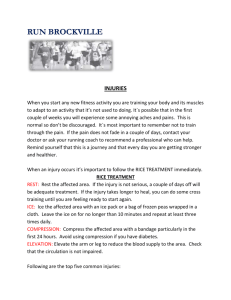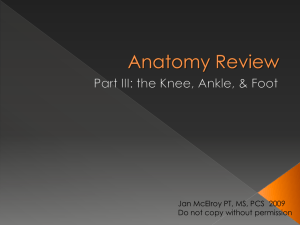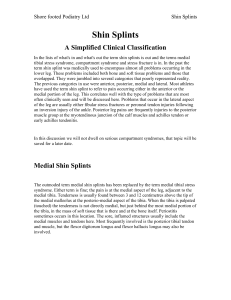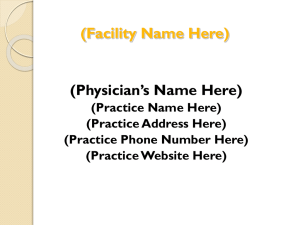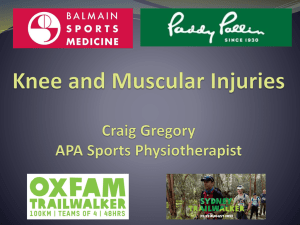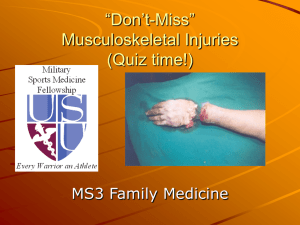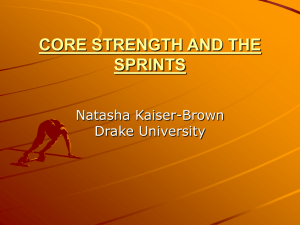Document
advertisement
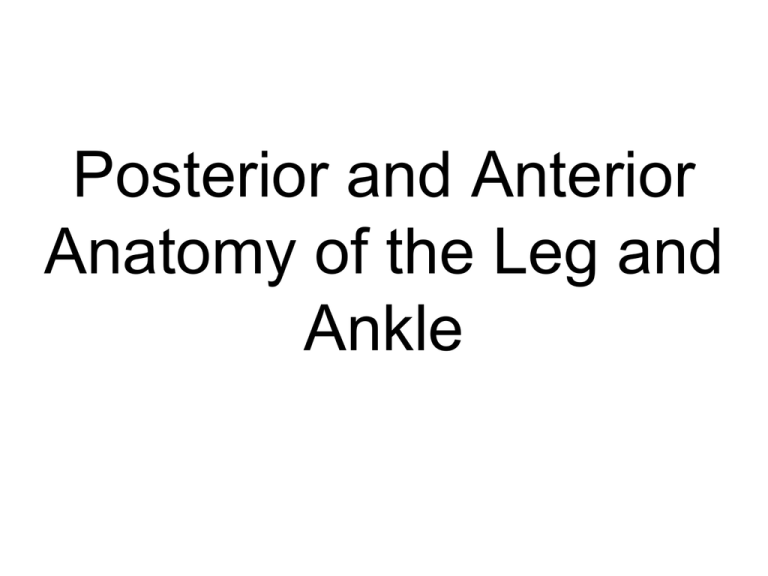
Posterior and Anterior Anatomy of the Leg and Ankle Plantarflexors of the Lower Leg • Gastrocnemius • Soleus • Plantaris Gastrocnemius O: Medial and Lateral Femoral Condyles I: Calcaneus (heel bone) via Achilles or Calcaneal Tendon (strongest and thickest tendon in the body A: • Plantarflexion of Ankle • Flexion of Knee Integrated Function of Gastrocnemius • Assists in eccentric deceleration of ankle dorsiflexion • Assists in eccentric deceleration of knee extension • Assists in dynamic stabilization of the subtalar and tibio-femoral joint during functional movement Soleus • The soleus is deep to the gastrocnemius, but medial and laterally superficial Soleus O: Posterior Tibia and Fibula I: Calcaneus via Achilles Tendon A: • Plantarflexion of ankle • Inversion of ankle Integrated Function of Soleus • Assists in eccentric deceleration of ankle dorsiflexion • Assists in eccentric deceleration of ankle eversion • Assists in dynamic stabilization of the subtalar joint during functional movement Triceps Surae • Gastrocnemius and Soleus make up triceps surae and they are the primary movers of plantarflexion Plantaris O: Lateral Epicondyle of Femur I: Calcaneus via Achilles Tendon A: Plantarflexion of Ankle Integrated Function of Plantaris • Assists in eccentric deceleration of ankle dorsiflexion • Assists in dynamic stabilization of the tibio-femoral joint during functional movement Popliteus • • • • Located in the posterior knee The popliteus is deep to the gastrocnemius and plantaris Most important stabilizer of the posterior knee Unlocks the knee by laterally rotating the femur on the tibia during a closed chain movement (foot in contact with the ground) Popliteus O: Lateral Condyle of Femur I: Proximal Posterior Tibia A: • Medial rotation of the tibiofemoral joint • Knee Flexion Integrated Function of Popliteus • Assists in dynamic stabilization of the tibiofemoral joint • Assists in eccentric deceleration of lateral rotation of the tibiofemoral joint • Assists in eccentric deceleration of knee extension Calf Raise • When the knees are extended, the gastrocnemius is the prime mover, because it is fully stretched and is more effective at producing force in an extended knee position, when compared to a flexed knee position. • The seated calf raise causes the gastrocnemius to shorten and the soleus, which does not cross the knee, takes most of the load Exercises for Gastrocnemius • Standing Calf Raise (Floor, BOSU, Disk) • Standing Single Leg Calf Raise • Standing Calf Raise with Tubing • Calf Raise on horizontal leg press • Prone or Seated Leg Curl • SB Leg Curl Exercises for Soleus • Seated Calf Raise (Machine, SB) • Single Leg Seated Calf Raise Stretches Slant Board ProStretch Stretches Gastrocnemius Stretch Soleus Stretch PNF Flexed Knee Hold-Relax • With the knee flexed it focuses the stretch on the Soleus. • This stretch is appropriate for all clients who are free of ankle and knee pathology, i.e., sprained ankle, torn meniscus, postop ACL. • Have client lie prone • With client lying prone, flex knee to 90 degrees • Passive prestretch (10 seconds), isometric hold (6 seconds), passive stretch (30 seconds) • Autogenic Inhibition Injuries • Achilles Tendon Rupture – Sudden forced plantar flexion of the foot, direct trauma, result of chronic tendonitis • Achilles Tendonitis – Common in runners and walkers • Calf Strain – Gastrocnemius or soleus • Calf Tear – Gastrocnemius or soleus is pulled from the achilles Primary Dorsiflexor of the Lower Leg • Tibialis Anterior • Superficial anterior muscle of the leg • Lies just lateral to the tibia Tibialis Anterior O: Lateral Condyle of Tibia and Lateral Surface of Tibia I: Medial Foot: 1st cuneiform and 1st metatarsal A: • Dorsiflexion of ankle • Inversion of ankle Integrated Function of Tibialis Anterior • Assists in eccentric deceleration of ankle plantarflexion • Assists in eccentric deceleration of ankle eversion Plantar Fasciitis • Pronounced “plantar fash-eee-eye-tiss” • Most common condition of heel pain • The pain is usually located close to where the achilles tendon inserts into the calcaneus • It is commonly thought of as being caused by a heel spur, but research has found that this is not the case. On x-ray, heel spurs are seen in people with and without plantar fasciitis (Mayo Clinic) Plantar Fascia Ligament • The plantar fascia ligament is located on the bottom of the foot and extends out towards the toes • It is a continuation of the Achilles tendon • It supports the medial arch of the foot • During walking, the plantar fascia ligament will stretch and contract as the weight is put through the foot Plantar Fasciitis • The condition occurs when the plantar fascia ligament is under constant stress and stretch. The ligament becomes inflamed and begins to tear off from the calcaneus bone Symptoms of Plantar Fasciitis • Heel pain • Pain is usually felt in the morning because the fascia ligament tightens up during the night during sleep • It is difficulty to get out of bed and place pressure on the ligament • Pain usually decreases as the tissue warms up, but may easily return again after long periods of standing or weight bearing, physical activity, or after getting up after long periods of sitting Plantar Fasciitis • Risk factors include: – Foot arch problems (both flat foot and high arches) – Obesity or sudden weight gain – Pregnancy – Excessive Running or Jumping – Tight Achilles tendon – People with Arthritis in their foot – People with Diabetes due to peripheral neuropathy – Wearing high-heeled shoes or improperly fitted shoes – Occupation-people who are on their feet throughout the day Treatment of Plantar Fasciitis • PRICE –Protection, Rest, Ice, Compression, Elevation • • • • Calf Stretches Calf Strengthening Arch Supports Medication prescribed by physician Exercises for Plantar Fasciitis • Gastrocnemius Towel Stretch – Loop a towel around the ball of the foot and pull the towel toward the body, hold this position for 30 seconds. Repeat 3 times • Frozen Can Roll – Roll the affected foot back and forth from the heel to your mid-arch over a frozen juice can. This exercise may be helpful if done first thing in the morning • Towel Pick-Up – Pick up a towel with the toes • Seated Toe Tapping Exercises for Plantar Fasciitis • • • • • Resisted Dorsiflexion and Plantarflexion Resisted Inversion and Eversion Standing Gastrocnemius Stretch Standing Soleus Stretch Single-leg Balance Shin Pain Conditions • Shin Splints • Anterior Compartment Syndrome • Stress Fracture Shin Splints • The shins have to bear as much as six times our body weight during sports and exercise • Shin splints, also called Periostitis is the name given to pain at the front of the lower leg. • There are two types of shin splints: –Anterior and Posterior Shin Splints • Anterior shin splints occur in the front portion of the shin bone (tibia). • Posterior shin splints occur on the inside (medial) part of the leg along the tibia. • Excessive pronation contributes to both anterior and posterior shin splints Shin Splints • Inflammation of the periosteum (sheath surrounding the bone) of the tibia • Causes: –OVERUSE!!! –Runners who increase their mileage –Poor running shoes/insufficient shock absorption –Runners who change the surface on which they are running –Excessive pronation (eversion) of foot Causes of Shin Splints • Muscle imbalances –tibialis anterior is tight • Walking uphill • Overtraining • Walking faster than normal • Jumping • Running stairs Symptoms of Shin Splints • • • • • Tenderness over the inside of the shin Lower leg pain Sometimes some swelling Lumps and bumps over the bone Pain when the toes or foot are bent downwards • A redness over the inside of the shin Treatment of Shin Splints • PRICE: Protection, Rest, Ice, Compression, Elevation • Ice: Apply ice packs to your shin for 20 to 30 minutes every 3 to 4 hours for 2 or 3 days or until the pain goes away. • Ice massage: Freeze water in a Styrofoam cup. Peel the top of the cup away to expose the ice and hold onto the bottom of the cup while you rub ice over your leg for 5 to 10 minutes. • Medicine: Take anti-inflammatory medicine as prescribed by your health care provider. Treatment of Shin Splints • Shoe supports: Arch supports (orthotics) help correct over-pronation. They can be prescribed and custom-made or you can buy pre-made arch supports at your local pharmacy, shoe store, or sporting goods store. • Strengthening and Stretching the posterior and anterior calf muscles • Running in water • Surgery Prevention of Shin Splints • Prevent shin splints by strengthening the tibialis anterior muscle • Exercises for strengthening the tibialis anterior include: –Sit down and write the letters of the alphabet in the air with your toes –Walk on your heels. Do several repetitions of 10 seconds and gradually work your way up to 30-second intervals Prevention of Shin Splints • Walk with feet turned inward and outward. • With socks off, gather up a towel that is flat on the floor, using only the toes • Pick up marbles using the toes Anterior Compartment Syndrome • A condition of the lower leg in which there is excessive muscle swelling or increased pressure in the muscles due to limited flexibility of the fascia surrounding the muscles in the lower leg • This swelling puts pressure on the blood vessels and the nerve supply of the lower leg and foot • If swelling continues, the blood vessels are compressed so much that blood flow to and from the muscle is shut off, and the nerves are pinched to the extent that the feet and lower legs go numb • Tibialis Anterior, Extensor Hallucis Longus, Extensor Digitorum Longus, and Peroneus Tertius may be affected Causes of Compartment Syndrome • • • • • • Overuse through exercise Pain which increases during exercise Bleeding/swelling in the compartment Weakness Motor loss The sheath becomes inelastic and unable to expand Treatment • Rest • Diagnosis and Treatment by a health care provider • Surgery- a small cut or two is made in the muscle sheath to allow the muscle to expand out Stress Fracture • An overuse injury that occurs when muscles become fatigued and are unable to absorb added shock • Eventually, the fatigued muscle transfers the overload of stress to the bone causing a tiny crack called a stress fracture Stress Fractures • Usually a result of increasing the amount or intensity of an activity too rapidly • Other causes: – Unfamiliar surface (tennis player switching surfaces, i.e. soft clay to a hard court) – Improper equipment (worn out shoes) – Increased physical stress (an athlete with a substantial increase in playing time) – Smoking makes it worse because it interferes with bone healing Treatment of Stress Fractures • PRICE: –Protection, Rest, Ice, Compression, Elevation • New Shoes • Non-weight bearing exercises –Swimming or cycling • Cane or crutches
